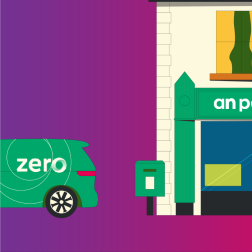- 7 mins read time
- Published: 16th July 2015
Drop and Shop style tips: How to edit your wardrobe
I’ve worked with Oxfam Ireland many times over the years and was thrilled when they asked me to support the Drop and Shop campaign – which is also a great scheme for you to get involved with.
I’ve always found Oxfam to be a great organisation to work with on shows and shoots – the staff and volunteers really know their stuff about fashion, both current and vintage, and have a great eye for merchandising. These events are the most fun for me to style because you never know what you might find when trawling through the stock.
Working with Oxfam on fashion shows, such as Belfast Fashion Week’s Charity Shop Challenge, always causes quite a stir. Over the years there have been near-riots backstage on more than a few occasions when models spy one-off desirable pieces that they wanted to buy – while at the same time members of the audience mobbed the Oxfam shop manager to buy the pieces straight off the catwalk.
DROP
I recently realised how many clothes I have (a lot), yet I tend to wear so few of them. You know how it is – you throw on whatever is handy, you rely on a certain style formula, a colour palette, a silhouette, a trademark. And there is nothing wrong with that, it’s important to have a personal style that suits you and your lifestyle. Honestly though, it’s easy to go from personal style straight into a style rut. I verge on this sometimes and I’m a stylist! I live and breathe this stuff.
A wardrobe fit to bursting sounds like the ideal scenario for any fashion-conscious person (or in my case, a room overflowing to another room, overflowing to the floor…) but the reality is that we wear 20% of our clothes 80% of the time. This means the majority of our clothes are sitting there, doing nothing. Getting in our way, occasionally sneaking into the laundry. It makes getting ready in the morning more taxing, as you wade through rails of ex-favourites to find the one thing you are looking for.

But these clothes could be doing something. A big something. Did you know that a high quality/one-off piece like a designer dress or a piece of furniture can raise vital funds and make a big impact on Oxfam’s work worldwide? For example, a jumper sold for £6/€8 at your local Oxfam Ireland shop could help purify around 2,000 litres of water, making it safe to drink for families living in makeshift camps in Nepal.
Take a few hours to go through your wardrobe. I bet you have loads of things you’ve only worn once or twice, or maybe never worn? Try them on. Why did you buy them in the first place? What do they work well with? Do you still like these pieces? Decide what to keep and what to ditch. Get rid of anything you haven’t worn for over 18 months (except occasion clothing and items with sentimental value), anything that no longer fits and anything with the labels still attached.
Bag these items up and drop then to your local Oxfam shop. I now do this regularly and it feels great. The relief of having a nice organised, clear wardrobe is fab. The feel-good factor, knowing that you are doing your bit to help Oxfam fight poverty and save lives in emergencies, is priceless.
There’s an extra pressure in these days of social media and the ever-present camera. With every event and night out charted on our Facebook and Instagram, people are feeling the pressure previously reserved for celebrities – being photographed in the same outfit over and over. It sounds silly but I bet it’s gone through your mind before. What better reason to bag up those old favourites and donate so that someone else has the chance to have a night out in that gorgeous dress and hopefully you can pick up something just as stunning when you #dropandshop – you get 15% discount on the day you drop. Share your experience on social media to be in with the chance of winning a refurbished iPad 2.
SHOP
I’ve been a trawler of charity shops since I was a little kid – first of all spending my pocket money on old Enid Blyton books and Judy annuals, then on slip dresses and grandad cardigans during the grunge years of the ’90s. Here are my top tips.
- Don’t take vintage/second-hand items at face value – body shapes have changed over the last century, so clothing may need alterations. Long skirts can be cut short, necklines altered, garments restyled. You should find a good dressmaker or learn how to use a sewing machine.
- Imagine a piece out of context. On a crowded shelf of scary figurines, or a rail of sad-looking frocks, you must try to see each item as an individual. Pick up every piece and imagine it out of context: in Urban Outfitters or Topshop, say or a cool boutique. Things which look tatty and unloved sometimes just need a bit of styling. Stand back, squint, and imagine how it would look somewhere really chic.

- Charity shopping does take a certain amount of commitment. You can’t just waltz in twice a year and hope to strike gold. Little and often is the best way, dash around your locals on your lunch break at least once a week. Get to know the volunteers so you can ask about stock that hasn’t been put on the floor yet.
- Find out what day your local charity shops receive their deliveries, so you can get first dibs on the good stuff.
- Check for any stains or damages to the garment and be sure it can be repaired.
- With proper vintage clothing, do try things on, and don’t trust the labels – ‘standard’ sizing has varied greatly since it was introduced in the 1950s – so a modern size 10 may find that a size 14 vintage garment is a perfect fit. On that note, different decades’ styles flatter different body shapes – the fit and flare silhouette and strong shoulders of the 1940s flatters pear shapes. The full skirts and cinched waists of the 1950s were designed for the hourglass figures, while apple shapes suit the empire line and shorter hemlines of the sixties. Slender figures can carry off the bias-cut of the 1930s and the long, lean looks of the ’70s.
- Wearing top-to-toe vintage can create a theatrical, fancy dress look – mix vintage with high-street and designer to create your own style and keep hair and make-up clean and simple.
- Don’t forget men’s clothing – the androgynous ‘boy meets girl’ look great. Look for oversized jackets and shirts to wear with slim cropped trousers. Shoulder pads can be removed and shoulders nipped in.
- It is more environmentally sound to buy second-hand – it is the most stylish form of recycling.
The ’70s is a big trend this season and next, with suede coats and jackets being one of the key pieces so keep an eye out for those. Leather pieces are also great investments with the bonus of already been worn in. Try something a bit different, charity shopping is a great time to take a risk and nab a bargain.
When you take your new finds home, see where they fit with your newly edited wardrobe. Mix and match to create new outfits and create a new personal and ethical style.




